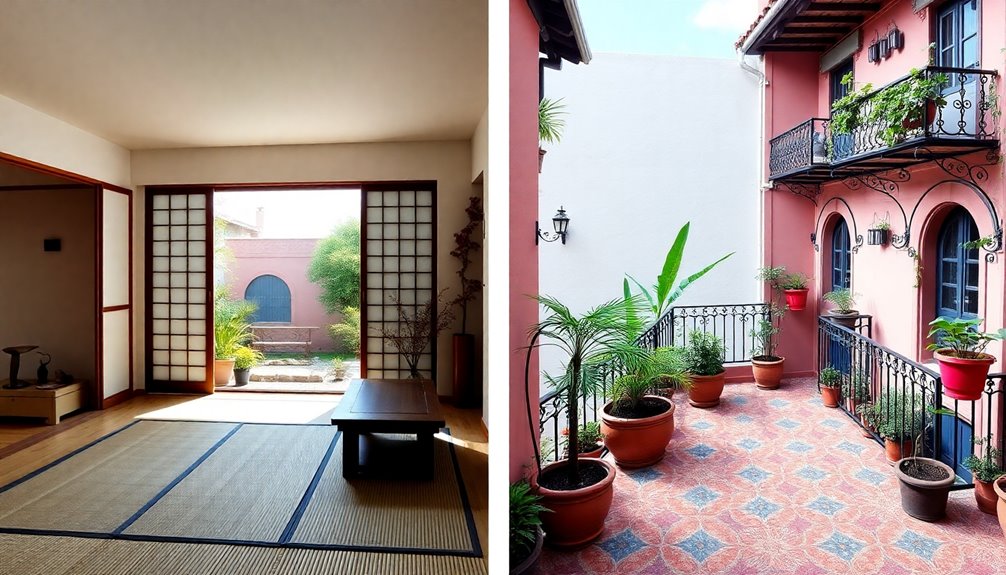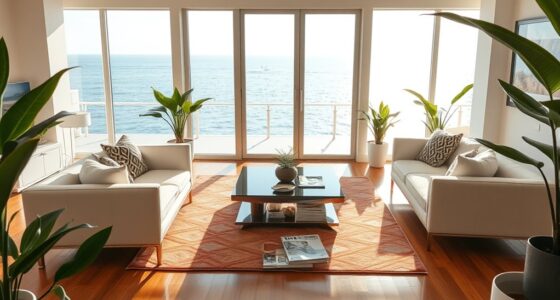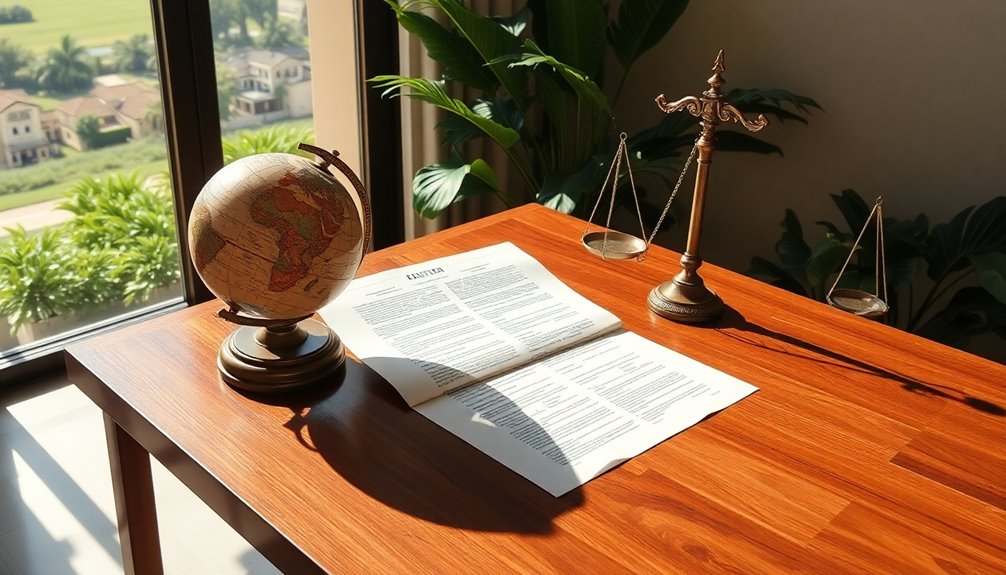Cultural differences play a huge role in home design, and as an expat, you should embrace these variations to enhance your living experience. Each culture has unique aesthetics, symbols, and color meanings that can guide your decor choices. Incorporating local materials and blending them with cherished elements of your heritage can create a comforting space. Understanding local design trends and participating in cultural practices adds depth and authenticity to your home. It's vital to stay mindful of cultural sensitivities while decorating, as this fosters connection and integration. If you're keen on enriching your living environment, there's so much more to discover.
Key Takeaways
- Cultural aesthetics influence home design, with elements like color symbolism and religious symbols varying significantly between regions.
- Blending personal heritage with local design fosters a unique living space that respects both cultures.
- Utilizing local materials enhances authenticity, sustainability, and connects the home to its environment.
- Understanding local design trends aids in making informed choices about style, functionality, and cultural integration.
- Incorporating traditional art and artifacts from both cultures creates emotional connections and promotes cultural appreciation in the home.
Understanding Cultural Aesthetics

Cultural aesthetics play an essential role in home design, influencing how spaces are shaped and decorated around the world. As an expatriate, understanding these cultural aesthetics can help you create a harmonious living environment that respects local traditions while showcasing your personal style.
Different regions have unique architectural choices and traditional practices that reflect their cultural heritage. For instance, Moroccan homes often feature intricate tile work and ornate carvings, while Scandinavian design emphasizes minimalism, natural light, and functionality.
Color symbolism also varies globally, impacting your paint choices and decor elements. You might love white for its representation of purity in Western cultures, but in some Eastern societies, it signifies mourning.
Additionally, consider how space is utilized; many Western homes favor open floor plans to promote social interaction, whereas Asian cultures often prefer segmented spaces for privacy and family cohesion. Understanding the importance of cultural aesthetics in home design can greatly enhance your integration into a new environment.
Personalizing Your Expat Home

Making your expat home feel uniquely yours involves blending elements from your home culture with local influences. Personalizing your space creates an eclectic environment that reflects your identity.
Start by incorporating decorative textiles like ethnic rugs, blankets, and tapestries. These elements not only add comfort but also enhance your home's visual appeal.
Display artifacts, wall art, and family heirlooms to reinforce your heritage and spark conversations with visitors. Using traditional clothing as decor can also add a unique touch—consider draping or hanging garments to celebrate your culture in a meaningful way.
Don't forget about culinary traditions; cooking familiar family recipes in your new kitchen evokes sensory connections to home. This practice can help alleviate homesickness while reinforcing your cultural identity. Additionally, consider investing in tableware that reflects both your heritage and local customs, enhancing your dining experience and connecting you to your roots.
Incorporating Local Materials

Incorporating local materials into your home design not only enhances its aesthetic appeal but also connects you deeply to the environment around you. By using traditional materials, like adobe or clay tiles in Mexico, you improve insulation against the local climate while showcasing cultural craftsmanship.
This approach promotes sustainability, as locally sourced stone or wood reduces the carbon footprint linked to transporting materials over long distances. Understanding the durability and maintenance needs of these materials guarantees you choose options that are both beautiful and practical for your new life as an expat.
Collaborating with local artisans can lead to bespoke pieces that not only celebrate the unique culture of your area but also strengthen community connections. For instance, Moroccan zellige tiles can add a distinctive flair to your home, reflecting the region's rich heritage while providing lasting beauty. Additionally, incorporating local materials can lead to a harmonious blend of indoor and outdoor spaces, enhancing your connection to nature.
By incorporating local materials, you create a living space that honors both the local culture and your personal style. Plus, you'll support the local economy, fostering a sense of belonging and connection in your new community.
Embrace the uniqueness around you, and let local materials transform your home into a true reflection of your surroundings.
Balancing Heritage and Host Culture

While you're settling into a new country, balancing elements from your heritage with local design aesthetics can create a harmonious living space that reflects both your roots and your new surroundings. Integrating decorative textiles, like ethnic rugs or heritage-inspired pillows, not only enriches your home but also showcases cultural significance.
To achieve a cohesive design, utilize common threads such as color palettes or patterns that resonate with both your heritage and the host culture. Engaging with local artisans can yield bespoke pieces that celebrate your identity while supporting the craftsmanship of your new community. Additionally, consider incorporating natural materials that are prevalent in Balinese decor for an added layer of authenticity.
Here's a simple table to help you visualize the blend of elements:
| Heritage Elements | Local Design Elements |
|---|---|
| Ethnic textiles | Regional craftsmanship |
| Personal artifacts | Contemporary art pieces |
| Cultural symbols | Local patterns
The Role of Color in Design

Color plays an essential role in home design, as it can evoke emotions, influence atmosphere, and reflect cultural identities. Your color preferences might differ greatly depending on where you're and the cultural traditions surrounding you. For instance, red may symbolize good luck in Chinese culture, while in the West, it often represents passion or danger.
In many Middle Eastern countries, you'll notice vibrant colors in home decor, creating a lively atmosphere, contrasting with the muted tones of Scandinavian design, which emphasizes simplicity and tranquility.
The psychological effects of color are vital; blue is popular in bedrooms worldwide for its calming properties. Additionally, incorporating nutrient-dense options like chia seeds into your diet may enhance your overall well-being, paralleling the importance of thoughtful color choices in creating a harmonious living space.
Understanding local color associations can enhance your cultural sensitivity. For example, white in some Asian cultures symbolizes mourning, whereas in Western contexts, it embodies purity and cleanliness.
During festivals in India, homes may burst with bright colors to signify joy, while Japan favors soft pastels to create serene spaces.
As you navigate your home design choices, keeping these cultural nuances in mind will help you create a harmonious living environment that respects and honors local traditions.
Furniture Choices Across Cultures

Furniture choices reflect the diverse values and lifestyles of different cultures. In Western cultures, you'll often find furniture designed for comfort and individual use, while many Asian cultures emphasize communal use, fostering social interaction. This difference highlights how cultural heritage shapes what's considered functional.
When it comes to materials, many indigenous cultures prefer natural materials like wood and bamboo, celebrating craftsmanship and sustainability. In contrast, modern urban environments often lean towards synthetic materials for their durability and ease of maintenance.
Aesthetically, the approach to design varies greatly. You might encounter ornate designs and vibrant colors in Moroccan furniture, showcasing intricate carvings and cultural flair. Meanwhile, Scandinavian designs often favor a minimalist approach with neutral tones, creating a calming atmosphere.
Color symbolism also plays an essential role in furniture choices. For example, red can symbolize good fortune in Chinese culture, influencing how furniture is selected and placed.
Understanding these cultural nuances will help you make informed decisions when furnishing your home abroad, ensuring that your choices resonate with the local customs and lifestyle.
Symbolism in Home Decor

When you look around your home, you might notice how certain religious symbols or cultural artifacts reflect your beliefs and heritage. These elements not only enhance your decor but also create a deeper connection to your identity and values. Understanding the significance behind these symbols can enrich your appreciation for the diverse ways people express themselves through their living spaces. Incorporating uplifting spiritual messages into your decor can further enhance the atmosphere of your home.
Religious Symbolism in Decor
Many people find that incorporating religious symbolism in home decor not only reflects their personal beliefs but also enhances their living space's spiritual ambiance.
As an expat, you might consider displaying common religious symbols, like crosses, mandalas, or om signs, as part of your decorative pieces. These symbols can evoke a sense of reverence and connection to your faith, while also contributing to your cultural identity.
Artworks depicting religious scenes, such as paintings or sculptures, serve as meaningful focal points that promote cultural appreciation and invite conversation.
Additionally, subtle accents like candles or prayer beads can be integrated into your home decor to create a calm atmosphere conducive to reflection and spiritual practices.
However, it's crucial to understand local customs surrounding religious symbolism to guarantee your decor choices are respectful and culturally appropriate.
Different cultures may have various interpretations of religious symbols, so take the time to learn and adapt.
Cultural Heritage Reflections
Incorporating cultural heritage into your home decor not only enriches your living space but also reinforces your personal identity and connection to your roots. You can achieve this by integrating traditional symbols, ethnic-inspired art, and family heirlooms that resonate with your background. Each piece tells a story, creating an emotional connection to your lineage.
For instance, consider using religious symbols like crosses or crescent moons to reflect your faith and cultural affiliation. Ethnic textiles such as rugs and tapestries enhance the aesthetic appeal while serving as educational tools for guests. They reveal the narratives of your heritage and can spark meaningful conversations. Additionally, incorporating Indonesian decor masks can bring a unique cultural significance and artistic flair to your home.
Here's a simple table to inspire your decor choices:
| Element | Purpose |
|---|---|
| Traditional Symbols | Express beliefs and values |
| Ethnic-Inspired Art | Adds aesthetic appeal and storytelling |
| Religious Symbols | Daily reminders of faith and identity |
| Family Heirlooms | Creates a sense of history and belonging
Navigating Local Design Trends

When you're designing your home, embracing local aesthetics can make a significant impact on its overall vibe.
By blending cultural influences, you not only create a unique space but also show respect for the heritage surrounding you.
Understanding what resonates in your area will help you make informed choices that enhance both style and functionality. Incorporating elements of modern farmhouse style can seamlessly blend rustic charm with contemporary design, appealing to local tastes.
Embracing Local Aesthetics
Embracing local aesthetics in your home design can transform your living space into a vibrant reflection of Moroccan culture.
Start by incorporating vibrant colors that are characteristic of Moroccan interiors, like deep blues, rich reds, and sunny yellows. Use traditional craftsmanship and intricate tile work to bring authenticity to your space, showcasing the skilled artisans in your community.
Opt for locally sourced materials such as clay, stone, and wood to enhance the authenticity and sustainability of your home. Familiarize yourself with Moroccan architectural styles, which often feature open layouts and inviting atmospheres that encourage communal living.
Design your spaces to prioritize areas where family and friends can gather comfortably.
Explore local markets and artisan fairs to discover unique decor items that resonate with Moroccan heritage. These items can help you personalize your living spaces, making them feel distinctly yours while honoring the local culture. Additionally, consider the importance of sustainable building practices to ensure your home design aligns with environmental consciousness.
Blending Cultural Influences
Blending cultural influences in your home design allows you to create a space that not only reflects your personal heritage but also honors the local environment. By incorporating local materials and techniques, you enhance your home's appeal while supporting the local economy and building community connections.
Understanding local customs is essential; it helps you navigate design choices that resonate with cultural significance. As you explore home design, consider how decorative textiles—like traditional rugs and tapestries—can bridge cultural differences. These elements add warmth and character to your space, celebrating both your heritage and local influences.
This blending of cultural influences results in a unique aesthetic that tells your story and pays tribute to your surroundings. Pay attention to the architectural aesthetics of your new home. Each region has its distinct style, which can inspire your design choices. Incorporating natural materials into your home can enhance the authenticity of your design choices.
Tips for Cultural Integration at Home

Cultural integration at home can be a rewarding experience that enriches your living space and fosters a deeper connection to your surroundings. To enhance this integration, start by incorporating local materials and design elements into your home decor. This not only showcases your appreciation for the host country's heritage but also bridges the gap between cultures.
Display traditional artwork and artifacts from both your home and host cultures. This practice creates a dialogue about identity and helps foster a sense of belonging.
Don't overlook decorative textiles—ethnic rugs and blankets can notably add comfort and aesthetic appeal to your living spaces while embedding cultural significance.
Engaging in local culinary practices can also facilitate cultural exchange and strengthen community ties. By incorporating traditional cooking tools and recipes into your kitchen, you'll deepen your connection to the local culture.
Finally, join local cultural events or workshops to gain valuable insights into design preferences and customs. This involvement not only enhances your understanding of your new home but also enriches your overall experience as an expat. Additionally, participating in local cultural events or workshops can also provide inspiration and ideas for designing your dream expat home. You may discover unique and innovative design concepts that you can incorporate into your living space, creating a truly personalized and authentic environment. By immersing yourself in the local culture, you can ensure that your expat home reflects not only your personal style but also embraces the customs and traditions of your new community.
Through these tips, you'll create a harmonious blend that celebrates both your identity and your new environment.
Frequently Asked Questions
How Can I Find Local Artisans for Home Decor?
To find local artisans for home decor, start by exploring local markets and craft fairs.
You can also check community boards and social media groups dedicated to your area.
Don't hesitate to ask locals for recommendations; they often know the best hidden gems.
Websites like Etsy can connect you with artists in your region.
Finally, visiting galleries or art schools can lead you to talented creators who specialize in unique decor items.
What Are Common Cultural Taboos in Home Design?
When it comes to home design, you'll encounter various cultural taboos that can impact your choices.
For instance, some cultures avoid placing mirrors directly across from doors, believing it invites negative energy. Others might frown upon using certain colors associated with mourning.
It's vital to research local customs and engage with your neighbors to guarantee you're respecting these traditions.
Understanding these nuances will help you create a harmonious living space that resonates with the community.
How Do I Respectfully Display My Cultural Artifacts?
When it comes to displaying your cultural artifacts, you've got to tread carefully.
Start by choosing a spot that showcases their beauty without overwhelming the space. Group similar items together for a cohesive look, and consider the stories behind each piece.
Use labels or descriptions to share their significance, inviting others to appreciate them.
Are There Specific Plants Favored in Local Home Designs?
When you think about plants in local home designs, consider what's trending in your area.
Many cultures favor specific plants for their beauty and symbolism. For instance, succulents are popular for their low maintenance, while ferns often symbolize new beginnings.
You might also find that certain flowers, like orchids or jasmine, are cherished for their fragrances.
It's a great idea to visit local nurseries to see what's commonly used and appreciated.
How Can I Research Local Design History?
You can plunge into local design history like a treasure hunter searching for gold!
Start by scouring libraries and online archives for historical texts. Connect with local historians or join community forums; they're often overflowing with insights.
Don't forget to explore social media groups focused on design trends!
Visiting museums or historical homes can add a real 'wow' factor to your knowledge. Immerse yourself, and you'll uncover fascinating stories behind the designs!
Conclusion
Embracing cultural differences in home design isn't just about aesthetics; it's like planting a garden. Just as each flower brings its unique color and fragrance, incorporating diverse elements into your home creates a vibrant tapestry that reflects both your heritage and your host culture. By blending local materials, colors, and furnishings, you cultivate a space that feels both familiar and new. So, take a moment to nurture your expat home—it's where your roots can grow in fresh soil.









